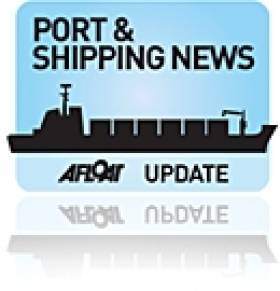Displaying items by tag: Cargo
Ship-to-Ship Transfer of OIl Cargo Delayed Yet Again
#SHIPPING - The transfer of hazardous cargo from the stricken tanker at the entrance to Belfast Lough has been delayed yet again due to winds nearing hurricane strength.
The Belfast Telegraph reports that the Genmar Conpanion - which was redirected to Belfast after reporting a cracked hull en route from Rotterdam to New York - will remain sheltering off the Copeland Islands until the weather improves.
As previously reported on Afloat.ie, the ship-to-ship transfer of 54,000 tonnes of vacuum gas oil was originally scheduled to take place on 31 December last, but the task was pushed back as the receiving ship, BW Seine, was delayed by weather in the North Sea.
It had then been hoped to begin the transfer early yesterday with the receiving ship's arrival, but the strong storm-force winds that have increasingly battered Ireland in the last 36 hours put paid to those plans.
Ship-to-ship transfers can take place in wind speeds of up to 35 knots, but yesterday the wind speed in Belfast Lough was reported as more than double that.
Hugh Shaw, the NI Secretary of State's representative for maritime salvage and intervention, told the Belfast Telegraph: "As soon as we have a window to do the ship-to-ship transfer safely we will take it.
"Winds have been dropping a bit, but it looks unlikely the operation will take place on Wednesday."
Transfer of Cargo from Stricken Tanker Delayed
#SHIPPING - The transfer of cargo from the damaged oil tanker sheltering at the entrance to Belfast Lough has been posponed for at least two more days.
As previously reported on Afloat.ie, the 228-metre Germar Companion - which is carrying 54,000 tonnes of vacuum gas oil - was redirected to Belfast after reporting a cracked hull en route from Rotterdam to New York.
The merchant vessel has been sheltering off the Copeland Islands since 16 December, where an official examination recommended removal of the cargo.
Today (31 December 2011) had been the scheduled start date for the move of the tanker's hazardous cargo by ship-to-ship tranfer. But the move has been delayed as the second ship, the BW Seine, is still en route to Belfast Lough.
"It is currently in the North Sea and could take another two days before it reaches the vessel and starts to transfer the cargo," a coastguard spokesperson told the Belfast Telegraph.
The transfer will be managed by specialist company Fendercare Marine in the lough, and could take between 24 and 36 hours. Once finished, the Germar Companion will sail into Belfast for repairs.
Cracks in Hull Force Tanker Re-Routing to Belfast
#SHIPPING - The Irish Times reports that a tanker carrying hazardous cargo has been allowed to berth at Belfast Port after it reported a cracked hull off the north-west coast.
The 228-metre Germar Companion, which is is carrying 54,000 tonnes of vacuum gas oil, was on route from Rotterdam to New York when its crew discovered cracking in its upper deck some 25 miles off Tory Island.
The Air Corps and Naval Service were stood down after the cargo ship was granted permission to berth at Belfast, where its hull will be inspected.
Belfast Harbour Trade Improves
Trade through Belfast Harbour is on the rise after a three-year drop, The Corkman reports.
Cargo through the port rose by 5% in the last year to 16.5 million tonnes, following a 10% fall since 2007 resulting from the global economic crisis.
While passenger numbers have fallen slightly, 35 cruise ships carring 62,000 visitors docked in the last 12 months. Meanwhile, bulk cargo trade was up by 12%, and grain and animal feed trade broke 2 million tonnes.
Salt shipments were also up my more than 200% due to the severe winter freeze.
The numbers will be good news to the Stormont Executive, which is expected to introduced a new levy on harbour trade to offset spending cuts.
Toxic Gases in Cargo Pose 'Substantial Health Risk'
European Union members must solve the problem of toxic gases in shipping cargo, says a new Dutch-based action group.
TGAV (Toxic Gases and Vapors) claims that research suggests more than one in 10 of all cargo containers throughout the EU "may have too high a concentration of hazardous gases or vapours".
The group says that these fumes are likely byproducts of the manufacturing process for a wide range products, from electronics and shoes to wooden furniture, clothing and toys, and even dried fruit.
"One example is the release of vapours from the glue used in sport shoes," it says. "After a three-week sea journey from China to for instance Europe, the concentration of gases and vapours can sometimes reach considerable levels."
The group adds: "The health risks for workers are substantial; in Germany and the Netherlands, several dozen cases of work disability are known in relation to the opening of containers."
TGAV notes that significant problems include the lack of warning labels on such potentially hazardous cargo, and low awareness within the logistics sector regarding the risks involved.
"In Europe, there is growing attention for the problem, but no coherent policy," says the group. "In order to ensure fair competition, a uniform approach should be implemented."
TGAV will host a conference next month in Brussels where the prospect of an EU policy on the problem will be discussed.
Dundalk Port Company
Dundalk Port Company
The Port is owned by Dundalk Port Company and is located on the North East coast of Ireland. It is ideally located as a gateway between Northern Ireland and the Republic of Ireland.
The Port, situated almost exactly halfway between the cities of Belfast and Dublin, enjoys major road connections to both cities via the N1 national primary road. This enables easy transportation of goods to both cities from Dundalk in about an hour.
The port offers a range of services including general cargo handling, pilotage, customs, etc.
Pilotage – Dundalk Port Company also provide a compulsory pilotage service which leads ships up the 8km stretch from the open sea. The Port is serve by a main pilot boat and an auxiliary boat.
Facilities – Ships of up to 3,500 dwt and 106m in length can be handled. Five 30-tonne crawler cranes at minimum radius are capable of discharging up to 160 tonnes per hour each. Ships of upto 3000 tons can be discharged in 12 hours.

About Dundalk Port
Dundalk Port has a long tradition of shipbuilding and registration.
The Port also has a long history of trading in different products with traffic through the port having consisted of gypsum, perlite, sand, peat, salt, scrap, pit props, cattle, fertilizers, machinery, paper, wood and general cargo to name a few.
The First vessel recorded as trading to Dundalk was the Trinitic which sailed from Liverpool to Dundalk in March, 1580. The year 1646 saw a grant of 'perfect freedom of trade' to Dundalk.
The harbour was naturally shallow and was left to its own devices until, in 1721 Lord Limerick, who at that time was high sheriff of Co. Louth, made a deal with the corporation to construct a harbour.
In 1740 he set about the construction of a quay in the form of a pier, extending into the river upstream from the present harbour. In 1767 the Irish Parliament voted £2000 and £400 yearly to improve the harbour. This sum was paid for 8 years and amounted in all to £5,200.
Early in the year 1800 Lord Roden appointed a harbour master and claimed authority over the harbour works. In 1803 the new Custom House was built and there was a military guard placed where goods were stored at the quays.
In 1840 an Act 'for regulating, preserving, improving and maintaining the river, port and harbour of Dundalk"'was passed. Under this act, 27 commissioners were appointed who had certain shipping and property qualifications.
In August 1848 a contract was signed and accepted for the construction of the pile lighthouse. The lighthouse was completed in June 1855. Soon after, in November 1860, a fog signal bell came into operation.
In 1967 work began to convert the lighthouse to electric and unwatched. The new light was exhibited on 17th December, 1968 with an increased intensity to 187,000 candle power in the white sectors. The fog horn signal was established on 25th June 1969.
In 1968 the B&I ended its Dundalk–Newry–Liverpool service. The last four ships on this service were MV Dundalk, MV Inniscarra, MV Wicklow and MV Kilkenny. The B&I compound was sold to the McGinnty family who used the premises for grain warehousing. This premises is now in the hands of Lockingtons Shipping, a subsidiary of Dundalk Port Company.
Towards the latter end of the 20th century, extensive work was carried out on the quays to repair, maintain and extend them to their current status. 220 metres of the current 400 metres of quay wall were just recently constructed in 1992.
In response to the steady rise in port traffic, 2 separate quays were linked with a new 25 metre stretch to form a single long, linear quay.
In 2002 Dundalk Port became a semi state limited company owned by the state. Captain Frank Allen is Chief Executive of Dundalk Port Company.
For a location map, please click here
Dundalk Port Company, 40 Quay Street, Dundalk, Co. Louth. Tel: 00353 (0)42 9334096 • Mobile: 00353 (0)87 2566594 • Fax: 00353 (0)42 9335481 • Email: [email protected]



































































